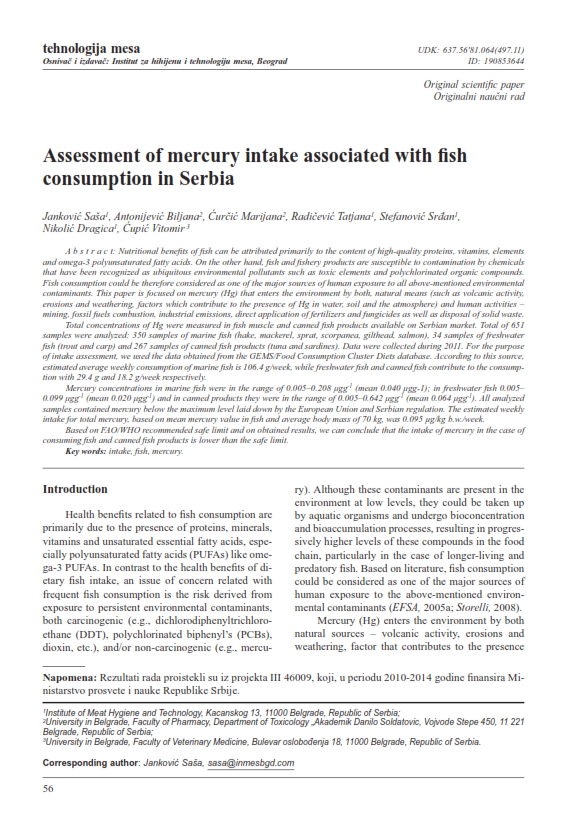Assessment of mercury intake аssociated with fi sh consumption in Serbia
Abstract
Nutritional benefi ts of fi sh can be attributed primarily to the content of high-quality proteins, vitamins, elements and omega-3 polyunsaturated fatty acids. On the other hand, fi sh and fi shery products are susceptible to contamination by chemicals that have been recognized as ubiquitous environmental pollutants such as toxic elements and polychlorinated organic compounds. Fish consumption could be therefore considered as one of the major sources of human exposure to all above-mentioned environmental contaminants. This paper is focused on mercury (Hg) that enters the environment by both, natural means (such as volcanic activity, erosions and weathering, factors which contribute to the presence of Hg in water, soil and the atmosphere) and human activities – mining, fossil fuels combustion, industrial emissions, direct application of fertilizers and fungicides as well as disposal of solid waste. Total concentrations of Hg were measured in fi sh muscle and canned fi sh products available on Serbian market. Total of 651 samples were analyzed: 350 samples of marine fish (hake, mackerel, sprat, scorpanea, gilthead, salmon), 34 samples of freshwater fi sh (trout and carp) and 267 samples of canned fish products (tuna and sardines). Data were collected during 2011. For the purpose of intake assessment, we used the data obtained from the GEMS/Food Consumption Cluster Diets database. According to this source,
estimated average weekly consumption of marine fish is 106.4 g/week, while freshwater fish and canned fi sh contribute to the consumption with 29.4 g and 18.2 g/week respectively. (mean 0.040 μgg-1); in freshwater fi sh 0.005–0.099 μgg Mercury concentrations in marine fish were in the range of 0.005–0.208 μgg -1(mean 0.020 μgg-1-1) and in canned products they were in the range of 0.005–0.642 μgg-1(mean 0.064 μgg). All analyzed samples contained mercury below the maximum level laid down by the European Union and Serbian regulation. The estimated weekly intake for total mercury, based on mean mercury value in fish and average body mass of 70 kg, was 0.095 μg/kg b.w./week. Based on FAO/WHO recommended safe limit and on obtained results, we can conclude that the intake of mercury in the case of
consuming fi sh and canned fi sh products is lower than the safe limit.





